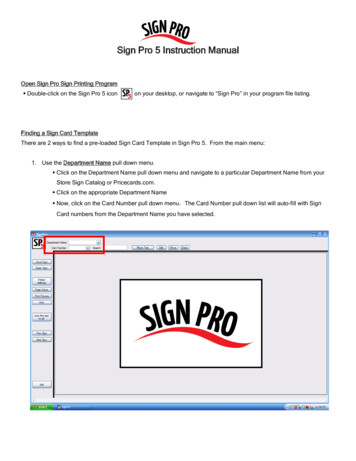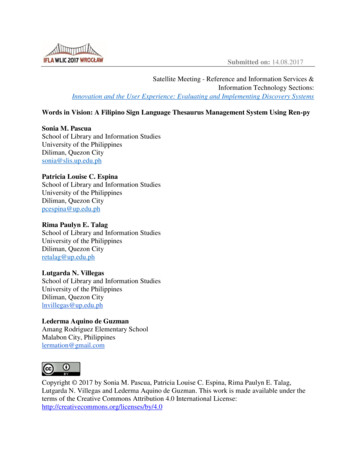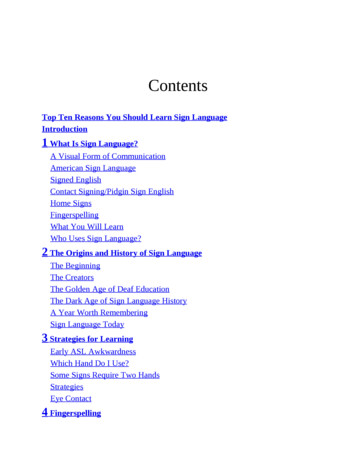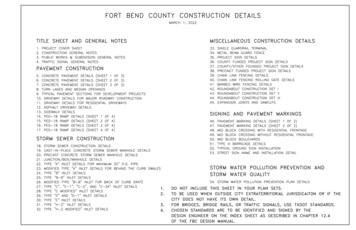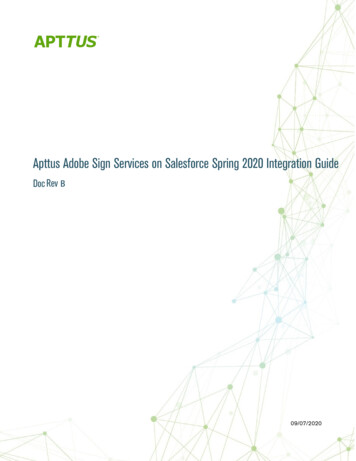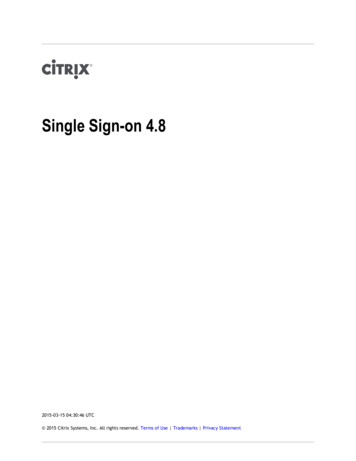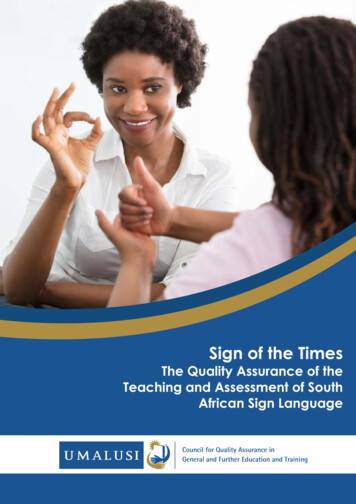
Transcription
Sign of the TimesThe Quality Assurance of theTeaching and Assessment of SouthAfrican Sign Language
SIGN OF THE TIMESThe Quality Assurance of the Teachingand Assessment of South African SignLanguage
COPYRIGHT 2018UMALUSI COUNCIL FOR QUALITY ASSURANCEIN GENERAL AND FURTHER EDUCATION AND TRAININGALL RIGHTS RESERVED.While all reasonable steps are taken to ensure the accuracy and integrity of the information containedherein, Umalusi accepts no liability or responsibility whatsoever if the information is, for whatsoever reason,incorrect, and Umalusi reserves its right to amend any incorrect information.ii
TABLE OF CONTENTSForeword . 1Acknowledgments . 2Acronyms and Abbreviations. 3Definitions of Terms/Concepts . 5List of Tables . 7South African Sign Language Fingerspelling . 8Executive summary . 9Introduction . 9Data and Research Methodology . 10Findings and Discussion . 11CHAPTER ONE: Background . 161.1Historical Background . 161.2Motivation . 181.3Purpose . 181.4Research Questions . 19CHAPTER TWO: Literature Survey – Approaches to Deaf Education in South Africa . 202.1Introduction . 202.2What is a Language? . 202.3What is Sign Language? . 212.4What is SASL? . 212.5Specific Aims of Learning SASL HL . 222.6Notes on Terminology . 232.7SASL HL Skills . 242.8An Integrated Approach – FP . 252.9SASL Approaches to Teaching and Learning . 252.10Sign Bilingualism as Described by the SASL HL CAPS . 262.11The Relationship between the LOLT and the LOL . 272.12SASL HL Teaching Model . 292.13Formal Assessment and its Purpose . 302.14SASL HL Skills and Assessment in the FP . 302.15SASL HL Skills and Assessment in the IP . 32iii
2.16SASL HL Skills and Assessment in the SP . 332.17SASL HL Skills and Assessment in the FET Phase . 352.18Essential Issues in Sign Language Assessment . 362.19Moderation of the Sign Language Assessment Tasks . 382.20Standardisation . 402.21Minimum Resources Required for SASL Home Language . 412.22SASL Laboratory Descriptions . 422.23Recording and Reporting for Grades 4-12 . 44CHAPTER THREE: Literature Survey – International Approaches to Deaf Education . 453.1Introduction . 453.2Deaf Education . 453.3Bilingualism in Deaf Education . 453.4Natural Sign Languages and Manual Codes for Spoken Languages . 483.5Approaches to Deaf Education in Singapore . 493.6Instructional Support to Deaf Education in Singapore . 543.7International Approaches to Assessment in Sign Language . 55CHAPTER FOUR: Methods . 624.1Introduction . 624.2Research Design . 624.3Research Instruments and Data Collection . 624.4Targeted and Accessible Population . 634.5Research Sample . 63CHAPTER FIVE: Research Results and Discussion . 645.1Introduction . 645.2Results and Discussion of Findings . 645.3Accommodations or Concessions . 755.4Challenges . 76CHAPTER SIX: Recommendations . 776.1Introduction . 776.2Areas of Good Practice . 776.3Areas of Concern . 786.4Recommendations . 786.5Conclusion . 80References. 82iv
FOREWORDIn publishing this report, Umalusi wishes to signal its commitment to the ideal of a moreresponsible and inclusive national system of education. Through its quality assurancerole, Umalusi aims to support the Deaf community in strengthening South African SignLanguage. Together, we will learn from international best practices, especially fromthe innovative work that South Africans are doing in our own country, and use thelessons and knowledge learnt to strengthen the teaching and assessment of SouthAfrican Sign Language as a Home Language.This report represents not the end, but the beginning of a journey in understandingand enhancing the South African Sign Language Curriculum. This curriculum has beenconstructed not only as the bedrock for learning and teaching in the Deafcommunity, but it also provides access to Deaf learners to truly learn and be taughtin their mother tongue.Umalusi’s work in quality assuring the curriculum and assessments of this new subjectis an important role, and the organisation approaches the task with great seriousness.As this report reveals, Deaf education has not always been given the respect andprominence it deserves, and indeed Deaf voices have not always been heard in theplanning of the system of learning and teaching.It is with great pleasure that Umalusi can report that with the launch of the SouthAfrican Sign Language Curriculum, a great step forward has been taken on the roadto equity and equality of learning for the Deaf community. Challenges still remain, asthis report will show, but we can look back on what has been achieved to date withpride and a feeling of hope as we travel along the road ahead of us.Dr MS RakometsiCEO of Umalusi1
ACKNOWLEDGMENTSUmalusi wishes to acknowledge:The leadership of Dr MS Rakometsi, Mr E Sibanda and Ms E Burroughs, who saw theneed for this project to be undertaken in order to prepare the organisation for qualityassurance of the assessment of South African Sign Language in 2018. A time, whichcoincides with the writing of South African Sign Language Home Language by the firstgroup of Deaf learners for the first time in the country, and the first Home Languageexaminations in any sign language in the world.Dr Stephan Mchunu for conducting the research and writing the report.The Quality Assurance of Assessments Unit of Umalusi under the leadership of Ms ZModimakwane and Ms M Madalane and the middle management for cooperationabout names recommended for potential Umalusi external moderators.Dr E Sujee, Senior Manager at Umalusi, for her continued support and encouragementduring the dissemination of the research findings and recommendations at Umalusi aswell as at local and international conferences. A sincere gratitude also goes to MrMohau Kekana (QCC Unit Assistant Administrator) for support in various ways duringfieldwork.Schools for the Deaf in Gauteng Province for opening their doors for theaccomplishment of this huge project. The Gauteng Department of Education HeadOffice (Special Needs Education Unit) for making time for Umalusi to gather therequired data for this project.The Department of Basic Education for the information that was collected duringgroup interview meetings and for allowing Umalusi to continue with its investigationduring South African Sign Language Home Language teacher training workshopscoordinated by Ms AM Schroeder.Professor M Kaneko and Ms N Janse Van Vuuren from the School of Literature,Language and Media at the University of the Witwatersrand for their inputs during theSouth African Sign Language teaching, learning and assessment information sharingthat took place at the University.Professor C Storbeck, the Director: Centre for Deaf Studies at the University of theWitwatersrand and Ms J Oosthuisen, Umalusi South African Sign Language HomeLanguage External Moderator, for their input during the information sharing sessionthat was held at Umalusi.2
ACRONYMS AND AIEBIEPIPISLJSLKSLLAKLOLTLOLLSFMIDNADNAONDPNQF Level 5NSCNZSLPanSALBPATPGCEQAAAnnual Assessment PlanAmerican Sign LanguageAustralian Sign LanguageAuditory Verbal TheoryCurriculum and Assessment Policy StatementChild of Deaf adultChinese Sign LanguageBritish Sign LanguageDepartment of Basic EducationDeaf child of Deaf parentDeaf child of hearing parentDeaf Federation of South AfricaGerman Sign language or Deutsche GebärdenspracheDeaf or hard-of-hearingDeaf teaching assistantFirst Additional LanguageFurther Education and TrainingFrequency modulationFoundation PhaseGeneral and Further Education and Training Quality Assurance ActGreek Sign LanguageHome LanguageHead of departmentHard of hearingIndividuals with Disabilities Education ActIndependent Examination BoardIndividual education programIntermediate PhaseIrish Sign LanguageJapanese Sign LanguageKenyan Sign LanguageSwahili Sign LanguageLanguage of learning and teachingLanguage of literacyFrench Sign LanguageMild intellectual disabilitiesNational Association for the DeafNatural auditory oralNational Development PlanNational Qualifications Framework Level 5National Senior CertificateNew Zealand Sign LanguagePan South African Language BoardPractical assessment taskPostgraduate Certificate in EducationQuality assurance of assessments3
SLNTODHHTSLUKTASLSingapore Association of the DeafSouth African Schools ActSouth African Administration Management SystemsSouth African Sign LanguageSchool-based assessmentSigned Exact English 2School governing bodySingapore Sign LanguageSign language education and developmentSenior PhaseScottish Qualifications AuthoritySingapore School for the DeafSingapore Signed EnglishNetherlands Sign LanguageTeacher of Deaf or hard-of-hearingThai Sign LanguageUnited KingdomTest of American Sign Language4
DEFINITIONS OF TERMS/CONCEPTSAssistive rsCochlear aEssay questionFrequencymodulation systemFrequencyGestureGlossingHandshapeLength ofparagraphLocationall types of electronic hearing aids, including personal aids, frequencymodulation systems, infrared systems, special input devices fortelephone or television, amplified alarms and signals, etc.an attitude based on pathological thinking which results in a negativestigma toward anyone who does not hearmembership of two cultures, such as Deaf culture and hearing culturebeing able to use two languages; for some Deaf children this will, forexample, be the use of sign language and Englishproductive morpheme that represents the visual appearance,placement, movement and/or handling of objects and animatebeings; classifiers do not occur in isolation but must be used with anoun referent; can be inflected to show pluralisation, position andverb movementan electronic device surgically implanted to stimulate nerve endingsin the inner ear (i.e. cochlea) in order to receive and process soundand speechsame as in English Home Language but presented in sign language.It is different from in a spoken home language in the way it ispresented in sign language and the way it is answered in signlanguage. Cognitive demands still applysame as in English Home Language but presented in sign languageSame as in English Home Language but presented in sign language,however, this is a new concept in sign language. There is noprescribed sign language drama at present, but the Curriculum andAssessment Policy Statement gives direction on what is to be taughtin drama.same as in English Home Language but presented in sign languagean assistive listening device that transmits the speaker’s voice to anelectronic receiver in which the sound is amplified and transmitted tothe student’s ears via small earphones on the student’s personalhearing aid. The device reduces the problems of background noiseinterference and distance from the speakerthe number of vibrations per second of a sound. Frequency,expressed in Hertz (Hz), determines the pitch of soundmovement of any part of the body to express or emphasise an idea,an emotion, or a function. Not part of a formal communication systema way of representing signs and non-manual features in printed words.For example, a signed word for mother is written as MOTHER (in capitalletters)this parameter refers to the shape of the hands at onset; formadopted by the hand depending on the position of the fingersa paragraph in sign language is referred to as a chunk and length isdetermined by time in minutesthis parameter refers to where the sign is articulated, either on thebody or the signing space5
MorphemeMovementNews itemNon-manualfeaturesPalm orientationParametersquestion papersSemanticsSpeechSyntaxa linguistic unit of relatively stable meaning that cannot be dividedinto smaller meaningful partsthis is the parameter within which the direction, speed, repetitionand manner are important when conveying the meaning in signingthis is usually a non-fiction piece that is presented to inform theaudience in sign languagethese actions are produced by any part of the body from the waistup, other than the hands, and carry grammatical meaning by usingmovements of the eyes, eyebrows, head, or shoulders and variouskinds of facial expressions using lip, cheek, and tongue movement;no English equivalentthis is the parameter that describes the direction of the palm and/orfingertips during the production of the signthese are the five characteristics or basic parts of a sign, namelyhandshape, location, palm orientation, movement and non-manualfeaturesSASL ‘papers’ are presented as video textsthe use in language of meaningful referents, in both word andsentence structuresa presentation in sign language that communicates to its viewers asa speech would to a hearing audiencedefines the word classes of language (i.e. nouns, verbs, etc.) and therules for their combination (i.e. which words can be combined andin what order to convey meaning), also known as grammar; majorsign categories i.e. lexical and parts of speech6
LIST OF TABLESTable 2.1: Skills used in SASL HL and English Home Language24Table 2.2: SASL Home Language and Description25Table 3.1: Singapore Sign Language and Gestures497
SOUTH AFRICAN SIGN LANGUAGE FINGERSPELLINGSouth African Sign Language fingerspelling is a manual representation of the alphabetof a written language; there is a one-to-one relationship between the letters of thespoken language and the handshape. As such, South African Sign Languagefingerspelling is not signed language, but it is used by signers to represent the writtenform when needed (e.g. proper nouns, acronyms and technical jargon).8
EXECUTIVE SUMMARYIntroductionHistorical BackgroundSouth African Sign Language (SASL) is one of the visual-spatial native languages usedby the Deaf community in South Africa to learn, communicate, express thoughts,feelings and abstract ideas. The ability to communicate is a basic human ability,including those in the Deaf community. SASL is a distinct language which uses specialfeatures for communication different from those in all other spoken languages in SouthAfrica. The distinguishing feature of signed languages is that they are communicatedthrough the medium of space, not sound, and that they use hands, face, head andupper torso for their realisation.The SASL is at present not an official language of South Africa, but it is recognised andprotected in various legislative and governmental policies and is even acknowledgedas a language equal in status to the 11 official languages in the country. TheDepartment of Basic Education has recently developed and introduced the SouthAfrican Sign Language Home Language Curriculum and Assessment Policy Statementfor the Deaf to be offered in schools. The Policy for South African Sign LanguageGrade 9 was implemented simultaneously with South African Sign Language in theFoundation Phase. This means, South African Sign Language was introduced as asubject to pupils in Grades R to Grade 3 and Grade 9 in 2015. In 2016, South AfricanSign Language was introduced to the Intermediate Phase (starting at Grade 4) andin the Further Education and Training Phase (starting at Grade 10). Grade 12 Deaflearners will complete the National Senior Certificate with South African SignLanguage Home Language in 2018.Umalusi has to understand the curriculum for quality assurance purposes, and this wasthe impetus behind this research project.Aim of the StudyThe aim of the study was to provide guidance to Umalusi in its role as the quality assurerfor SASL Home Language SBA and examinations. The scope of the SASL Project alsoencompassed understanding how Deaf learners are assessed as well as the kind ofresources and materials required for assessment, including identifying potentialnational moderators and evaluators.9
Data and Research MethodologyDataData collection involved the following:Literature review (including of the SASL Home Language CAPS) focusing on teaching,learning and assessment processes and procedures for SASL as well as the qualityassurance of the assessment of sign language by other countries.Key informant interviews took place to obtain detailed information relating to formalassessments, marking of scripts, moderation and verification of SBA, moderation ofquestion papers, and verification of marking, monitoring and evaluation of the stateof readiness, examination writing and marking. Face-to-face, one-on-one and inperson interviews were conducted with the DBE (Item Development Unit) specialistsand officials, experts from schools for the Deaf as well as experts from the University ofthe Witwatersrand. Interviews were also conducted with the SASL HL curriculumdevelopers from the DBE.Observation of teaching and assessment practices with the seven Deaf schoolsincluded in the study. During observation, the researcher’s role remained one of animpartial, non-participatory observer. All the Gauteng Province schools that werevisited gave permission for photos and videos to be taken. However, these photosand videos could not be made available for public consumption due to ethicalreasons.MethodResearch DesignThe SASL Project is largely located within the qualitative research paradigm andapplies a case study approach involving the DBE (Item Development Unit), seven SASLschools for the Deaf selected from Gauteng Province and the University of theWitwatersrand.Targeted and Accessible PopulationIn this study, all schools offering SASL HL in South Africa constitute the targetpopulation. These schools form a natural grouping per province and per phase inrespect of this research topic. In terms of the accessible population, this consisted ofall schools offering SASL HL in Gauteng Province.Research SampleNon-probability convenience sampling was used to select schools. The sampleconsisted of schools offering SASL HL in Gauteng Province. All seven schools for theDeaf in the Province participated.10
Findings and DiscussionResults and Discussion of FindingsSeven schools for the Deaf were visited in Gauteng Province. Of these, two had Grade9 as the highest grade, two Grade 10 and three had Grade 11. One of the schoolshas a Grade 10 bridging class. In 2018, Gauteng Province will have two schools withlearners writing SASL HL examinations at an exit level (Grade 12). Two schools offerGrade 12 over two years. One of these schools will write SASL Home Language in 2019and another will write SASL Home language in 2020 since its learners started SASLHome Language in Grade 10 in 2017.Teacher QualificationsIt is clear that regarding teacher qualifications, expertise in relation to SASLqualifications is lacking. This is a worldwide challenge. Hearing teachers, most ofwhom are not fluent SASL users, continue to dominate the educational process.Large numbers of teachers may be unaware of the linguistic differences between ASLand English-based sign systems. In addition, the privileging of English over ASL causesmany teachers to change ASL from a rich, fully formed language to a manuallycoded version of English. For this reason, in South Africa SASL HL is strictly promotedover Signed English or any other spoken language. In other countries, like Singapore,they have SEE. This dilutes the purity and the linguistics of sign language. To overcomethese risks of dilution, it is important that teacher preparation programmes adequatelyinstil sign language proficiency (fluency) in their students. The DBE provides ongoingworkshops and training for SASL teachers as does the University of the Witwatersrand.Teaching and LearningAll the schools that were visited follow the SASL HL CAPS curriculum which has fourlearning outcomes: Observing and Signing, Visual Reading and Viewing, Recording,and Language Structure. The findings show that SASL HL is the LOLT in all the schoolsthat were observed. In some schools, teaching and learning takes place throughPowerPoint presentations. Teaching and learning focuses on the SASL Parametersincluding: reading, viewing, comparing, phonological awareness and the structure ofthe language.The implementation of SASL HL needs teachers with both teaching and SASL skills,however there is a lack of qualified Deaf teachers to teach SASL as a result of barriersto tertiary education and teacher training for Deaf South. In the absence of aqualified Deaf teacher, the Curriculum Management Team (appointed by theMinister of Basic Education in 2010) proposed a bilingual-bicultural team teachingmodel in which a hearing teacher is paired with a DTA. In this model, the DTAs have11
expertise in SASL and the qualified hearing teachers in teaching methodologies,classroom practice and the English-based curriculum.Schools use DVDs from SLED for language structure. Learners watch and observe asigned story from the video and thereafter relate the story through signing whilst beingvideoed. One of the schools indicated that teachers use textbooks borrowed fromEnglish HL. There are no SASL HL textbooks. Whatever textbook is chosen, thecurriculum of the SASL course should reflect four broad areas: grammatical featuresof SASL, the lexicon of SASL, practice with SASL conversational skills and culturalawareness.Assessing SASL Home LanguageThe findings show that the learners’ signing skills are assessed through Recording,Observing and Signing, and Visual Reading and Viewing. All assessments arerecorded and rubrics are used for marking. No pen and paper were used during theassessment of SASL HL. One of the schools observed used a hard copy question paperand learners signed the answers. This situation is not ideal for SASL HL assessments.Preferably, learners should have access to laptops with webcams and all questionsshould be signed and recorded using the laptops. In all of the schools observed, SASLHL assessment takes place in a SASL laboratory and in the presence of both thequalified hearing teacher and the DTA.The learners’ SBA portfolios are kept on memory sticks and on computer hard drives.The memory sticks are retained by the school for security reasons. The teachers’ filesare kept as hard copies (memo) and digital copies of question papers. The learners’files are also kept as hard copies of marked answer sheets and digital copies ofanswers.Internal and External ModerationSchools use pre- and post-moderation tools for the internal moderation of the learners’assessments. Some schools have School Assessment Teams (SATs) that are responsiblefor the quality assurance of the internal assessment and moderation. In some schools,teachers teaching senior classes/grades moderate question papers for teachersteaching junior classes/grades. Information provided by one of the nationalexaminers for SASL HL indicates that the HOD or another SASL teacher usually doesinternal moderation at school level. The requirement is that the moderator shouldhave SASL HL proficiency and be knowledgeable about phase-specific content. Thetools for internal moderations (SASL pre- and post-assessment moderation) werecirculated to SASL HL teachers nationwide to use during moderation.The SASL subject advisors had not been appointed during the time of the writing ofthis report. As a consequence, provincial or national external moderation had not12
taken place. But, the DBE uses the spoken language subject advisors in the interim tocheck if schools comply with the CAPS policy.Sources of ExpertiseData from the schools relating to sources of expertise to moderate the assessmenttasks indicate that Deaf schools from the Gauteng Province draw their expertise fromthe University of the Witwatersrand and SLED. The University of the Witwatersrand andthe University of the Free State are the only two universities in the country currentlyoffering SASL training to teachers.In terms of expertise for internal moderation, the HODs, and in some schools theprincipals, do pre- and post-assessment moderation of the SBAs. Teachers alsomoderate each other’s work. However, the lack of qualified SASL HL teachers meansthis expertise is spread very thinly. Some schools draw additional expertise fromteachers for other subjects such as English HL; however such teachers can onlymoderate the written form of the assessment since they are neither fluent in signlanguage nor are they sign language experts.Some schools have teachers that are qualified in special needs education or inclusiveeducation but with no specialisation in Deaf education or in SASL. One school hadthree qualified DTAs, two with SASL NQF Level 5 and one had a BEd, Honours in DeafEducation and SASL NQF level six. This is commendable. However, some schools relyon DTAs as native and fluent signers to do the moderation of the SBA tasks. Teachersin one of the schools visited confessed that they are unsure if they are moderating theassessmen
same as in English Home Language but presented in sign language Drama Same as in English Home Language but presented in sign language, however, this is a new concept in sign language. There is no prescribed sign language drama at present, but the Curriculum and Assessment Policy Statement gives direction on what is to be taught in drama.

